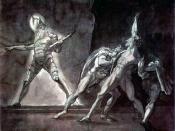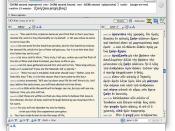Read Act I of the play, then go to the assignment and list at least two examples for each of the language patterns you have found in Act I. Give the scene and line number where you find each example.
1. Unusual word arrangement
I could a tale unfold (I, v)
In my mind's eye (I, ii)
It cannot come to good (I, ii)
It started like a guilty thing (I, i)
Leave her to heaven (I, v)
More honoured in the breach than the observance (I, iv)
More in sorrow than in anger (I, ii)
Neither a borrower, nor a lender be (I, iii)
Not a mouse stirring (I, i)
O my prophetic soul! (I, v)
Something is rotten in the state of Denmark. (I, v)
So much for him (I, ii)
There are more things in heaven and earth, Horatio, Than are dreamt of in your philosophy. (I, v)
This too too solid flesh (I, ii)
To thine own self be true (I, iii)
2. Omissions
'Tis bitter cold (I, i)
'Tis true: 'tis true 'tis pity,
'Tis now struck twelve; get thee to bed, Francisco (I, i)
3. Words not quite our own (unusual words)
That it should come to this! (I, ii)
All is not well (I, ii)
Frailty, thy name is woman! (I, ii)
Give thy thoughts no tongue (I, iii)
I am sick at heart (I, i)
tis = it is; ope = open; o'er =over; gi' = give; ne'er = never; i' = in; e'er = ever; oft = often;
a' ~=he; e'en = even
1. Second person pronouns: thou, thy, thine, ye
2. Verb inflection:
second person thou + a-t, -st, or -est = thou art, thou seemest; may be contracted: thou seem'st
third person he, she, it + add -eth =...


